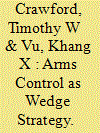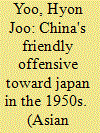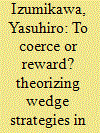| Srl | Item |
| 1 |
ID:
181390


|
|
|
|
|
| Summary/Abstract |
Strategic arms control is in crisis. The United States and Russia have retreated from agreements that formed the framework for post–Cold War arms cuts and strategic stability, such as the Anti-Ballistic Missile Treaty, the Treaty on Conventional Armed Forces in Europe, and the Intermediate-Range Nuclear Forces Treaty. The only strategic arms control agreement between the United States and Russia (i.e., New START) expires in 2026. The political forcefield that sustained the old framework has been altered by major technological revolutions and China's rise. Motives for strategic arms control are conventionally framed in terms of their potential to enhance stability by limiting certain weapons, avoiding costly arms races, or preserving military advantage. But states can also use strategic arms control to divide adversaries. Wedge strategy theory explains how arms control can do so by affecting adversaries' threat perceptions, their beliefs about the costs and benefits of formal commitments, and their degree of trust in one another. Three landmark strategic arms control negotiations (the Five-Power Treaty and the Four-Power Treaty at the Washington Naval Conference, the Limited Nuclear Test Ban Treaty, and the Strategic Arms Limitation Talks) show how the wedge motive informed these negotiations and influenced great power relations. The wedge logic remains relevant today. For example, the United States may employ future arms control agreements to drive a wedge between China and Russia, and it must be cautious about arms control deals with North Korea that would negatively affect its relationship with South Korea.
|
|
|
|
|
|
|
|
|
|
|
|
|
|
|
|
| 2 |
ID:
137183


|
|
|
|
|
| Summary/Abstract |
This article explores why the People's Republic of China employed a surprisingly soft and lenient policy toward Japan in the 1950s despite their historical and political animosities. Relying on a relatively new concept in the study of international relations, I argue that China's conciliatory policy toward Japan represented a wedge strategy that was designed to detach Japan from the United States and weaken the US-Japan alliance. The logic of the theory also reveals that China's policy was in line with its “united front” against the United States during the Cold War.
|
|
|
|
|
|
|
|
|
|
|
|
|
|
|
|
| 3 |
ID:
123397


|
|
|
|
|
| Publication |
2013.
|
| Summary/Abstract |
Wedge strategy, a policy of preventing or dividing an adversary coalition, has been attracting increasing scholarly attention. In particular, Timothy Crawford has articulated the concept and claims that reward-based strategies are more effective than coercive strategies that actually strengthen the ties between enemies. Although this sounds logical, history provides sufficient cases that contradict the claim. Why? To answer the question, I develop a theory of wedge strategy by utilizing the concept of reward power. I then argue that although countries seeking to divide adversary coalitions usually prefer reward-based strategies, they turn to coercive measures when a divider state perceives grave threats as a result of a target state's strong alignment with its primary enemy but does not have sufficient reward power to split the adversaries. I examine this theory through two case studies of us wedge strategies toward the Sino-Soviet alliance during the early Cold War period. This article addresses the specific puzzle of choices between reward and coercive wedge strategies and offers broader theoretical implications regarding the utility of the concept of reward power in international and alliance politics.
|
|
|
|
|
|
|
|
|
|
|
|
|
|
|
|
| 4 |
ID:
090927


|
|
|
|
|
| Publication |
2009.
|
| Summary/Abstract |
The article is devoted to the role of Yugoslavia in the foreign policy of the United States of America in the region of Eastern Europe in the 1960's and 1970's. The author underlines the importance of Yugoslavia to the United States in its "wedge strategy" directed towards the Soviet Bloc countries. It points out the role of economic relations and humanitarian cooperation in the achievements of the United States foreign policy aims during the Cold War era. The author describes the role of Yugoslavia in the process of encouragement of economic and political reforms towards liberalization in other Eastern European countries and defines the factors which justified the special role of Yugoslavia in American foreign policy. The author also analyses the role of Yugoslavian immigration in the development of American-Yugoslavian relations and defines the main directions of American foreign policy towards Yugoslavia after the withdrawal of J.B Tito from the political arena.
|
|
|
|
|
|
|
|
|
|
|
|
|
|
|
|